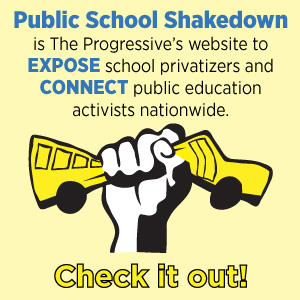The Greending of American Education
By Todd Lilly
As I have been traveling this summer talking to K12 and college faculty about the total transformation of American schools that is taking place right under our noses, people get this confused look on their faces: “What are you talking about?” That’s understandable; hard-working educators don’t have time to be watching their backs to make sure they are not about to be stabbed (metaphorically speaking). This, my first blog and the other blogs here on BustED Pencils are our way of looking out for you… but only if you read them…
——————————————-
650 billion dollars… That’s about how much America spends each year to educate our children. That’s not nearly as much as we spend on health care (about 250 TRILLION dollars), and less than we spend on our military operations (about 750 billion), but still, it is a prodigious sum. If you had that kind of money at birth and spent a million dollars each and every day of your life until your timely demise, you would still have hundreds of BILLIONS to leave to your surviving spouse, your surviving children, your surviving grandchildren, and your favorite animal shelter. Wow!
I know what you’re thinking: That’s a lot of money to spend on kids. How can I get a chunk of that change? Well, maybe you can. There are many who are making big bucks at the education trough. If you’re an entrepreneur who is thinking about getting your share of the 650 billion or if you’ve been sleeping for the last 30 years and just woke up, I’ve put together a short chronicle of events to bring you up to speed. Read on.
You’ll be happy to know you won’t need to start from scratch. The first and most important step towards setting the stage to rake in tax dollars was to convince the public that there was “trouble in River City.” (Meredith Willson’s Music Man isn’t a bad analogy if you take out the Madam Librarian bit.) You can thank the Reagan administration for putting a big one in the win column (another one for the Gipper). In 1981 his Secretary of Education (think: Robert Preston, a guy who can’t sing but plays the lead in a musical) put together a committee comprised overwhelmingly of school administrators and one token teacher (and no educational scholars) who looked at some student test scores and concluded that American schools were in such terrible shape they put the nation in peril. And whom did these administrators blame for such a threat to our Red, White, and Blue? (Clue: It wasn’t them.) Of course, the blame rested with lazy students and incompetent teachers (like those who don’t know when to use “them” or “they”). The report got a catchy nickname, A Nation At Risk, and the rest is history.
Obviously, somebody noticed the uncanny power of using standardized test scores to persuade the masses. Subsequent studies have found serious flaws in the committee’s data, but that’s fodder for some future blog. (Ever hear of the Simpson Effect? Neither did I.) The good news if you’re an opportunity-seeking entrepreneur is that the validity (or lack thereof) of the committee’s report had done its deed; there was “trouble, trouble, trouble right here” in the U.S. of A, and everyone needed a new band uniform. Substitute “school reform” for “band uniforms” and you begin to see the possibilities (Ca-Ching).
Remember the 80’s and 90’s? I do. We were deep into something we called “authentic assessment.” We had kids writing journal entries in which they reflected on things they read and they were allowed and encouraged to connect their learning to their lived lives. We had them construct portfolios to give evidence of their learning. The challenge in those days was for the teacher to know their students’ backgrounds enough to create portals through which kids could meaningfully engage the curriculum using skills they acquired when needed. Class discussions were extensions of what the kids wrote in their journals. This was a time when the so-called “Achievement Gap” was actually closing! To pull this off successfully required hard work on the teachers’ part, but it was exciting. I once had a 4th period class of high school seniors who would frequently all sit together during 5th period lunch and continue a heated class discussion that began in my class. (Appropriately, I wasn’t invited.) A student let this slip to me one day when he came back to the room to retrieve his lunch from his desk. Very cool.
There were real teachers in those days, like Nancie Atwell, Donald Murray, and Donald Graves, who led the charge. However, if you were into making lots of money, this wasn’t such a good thing. Why? Because it didn’t fit at all into a for-profit business model. It didn’t have a standardized commodity and it couldn’t be economically quantified for quality control and packaging. And let’s be truthful, teachers. Many of us weren’t willing to give up our evening television programs or weekends at the mall to do the kind of creative planning and responding to student work required to keep the momentum. (Ouch.)
In the blink of an eye, portfolios, journals, project-based learning, and other localized, classroom-centered, ground-up practices were dropped in favor of standardized practices that were developed far from the classroom. This was the beginning of the “lesson planning for dummies” movement that swept through school districts like wild fire. If you could come up with a few simple, generalized lesson plan templates, you could call yourself an “Educational Consultant” and travel the country raking in thousands of tax dollars selling your template to districts who would contract with you to give professional development seminars to their wayward teachers who just needed to be re-calibrated. If you were really into making money, you could multiply your efforts by hiring ex-teachers of varying experience to run these seminar sessions for you, or you could create a set of videos that could be sold to districts with royalty contracts. Virtually all of these were based on a business production efficiency model. There is still a healthy market for educational consultants. You don’t need classroom experience; you just need to come up with a commodity, such as a lesson template, or a vocabulary-building curriculum, or a set of lessons based on brain research. Make sure you throw in terms like “research-based, ” “rigor,” “grit,” and “Common Core,” and then go get yourself an accountant. Admittedly, some of these products and productions are useful. And some are just plain wrong. But they all seem to make money, and that’s what we’re talking about here.
You entrepreneurs could not have asked for a more fertile field to plant the seeds of profit-making enterprises than what was handed to you at the beginning of the 21st Century. First, you had a guy in the White House who had a history of making a ton of money with help from investors who paved his way into political office in return for “favors.” But in fairness, he only signed the No Child Left Behind bill; it was Ted Kennedy and John Boehner who collaborated on its drafting and passage through Congress. NCLB, and its grounding in standardized tests as a sole quantifiable measure of student performance was a gold mine for profiteers! President Obama’s Race To The Top legislation’s emphasis on testing to measure teacher accountability only paved the road to riches. There was money to be made creating the tests, money to be made preparing for the tests, and money to be made grading the tests. Lots and lots of money. And where did it come from? (Remember that 650 billion dollars that you and your neighbors paid to support your children’s schools?) Yep.
Here’s one of the best things to happen to the testing profiteers: Emboldened by the Federal Government’s tinkering with the Elementary and Secondary Education Act, the states adopted legislations that make it possible to tie teacher salaries and even their future employment to their students’ standardized test scores. And these laws contain similar and even identical wording as if they were written by the same lawyers and then disseminated to the states prepackaged… Hmmm….. And if you think the trusty unions will block such legislations, come to Wisconsin and check out what happens when the governor and the state legislature decide to condemn public employees.
And then came charter schools whose original intent was as laboratories where innovative teaching and learning practices could be tried and, if successful, could be brought back into the comprehensive schools. But public charter schools were soon followed by for-profit charter schools (independent) that lured parents with the often hollow promises of better performance on standardized tests. Here’s a tip: “Boot Camp” charter schools that fix poor kids’ bad behaviors through strict discipline not seen since the Spartans are what’s hot now.
And let’s also give credit to digital technologies, which have proven to be pure magic for the testing industry. Kids taking a standardized test with paper, even at the early-childhood level is virtually a thing of the past. Children as young as eight and nine are being forced to sit at computers for extended periods of time as they (and their teachers) are instantly assessed. In most cases, teachers are strictly forbidden from seeing the tests to prevent scamming and to allow reuse of test questions. Such secrecy also cuts down on scrutiny as to whether or not the exams are valid measures of… well… anything. The majority of these exams are produced and scored not by educators but statisticians. There are only five main companies nationally prominent in the testing business and they are making millions and millions of dollars (let’s add another “and millions” just for the heck of it). But don’t let that intimidate you from cashing in. You do not need any education experience or expertise to work for or own stock in these companies.
There is a French word that comes to mind now. The “denouement” comes at the end of the story when all the subtexts are brought together. If you are a lover of public schools, a teacher, or faculty at a School of Education, this is not going to go well. Let’s review the subtexts:
- American education sucks and it’s the lazy parents, students, and teachers that are to blame.
- Tests have been developed and administered by for-profit companies to prove #1
- Charter schools have been developed to cure #1
- Private for-profit companies are creating their own charter schools with public taxpayer money but with little if any accountability and they are getting away with it because, well… read #1
- Standardized tests have become the uncontested instruments to measure a child’s worth, the child’s teacher’s worth, and now…the worth of the child’s teacher’s college. Think about that. Think about the power that we (yes, we) have given over to five testing companies that won’t allow us to see the tests. Professional test makers (not to be confused with educators) have the expertise to create tests that maintain the Achievement Gap and, of course, undergird the assumption that energizes the whole for-profit system (see #1).
- Entrepreneurs are coming out of the woodwork to cash in with products from prescribed lesson plans to computer and tablet applications that promise to boost test scores because… (see #1).
So if you are still looking to make some money on the American education cash cow, here are a couple inside tips:
- Since teachers are lazy and inept, pre-scribed lessons are selling like hotcakes. So are prefab tests that students can take on-line with instant results. In a future blog, I will tell you how you can create lessons and on-line tests with little knowledge or experience. As more and more public schools become for-profits and voucher-supported private schools, the market is red-hot! (Tip: Amazon just entered the “download-a-lesson-plan” market and is hiring!)
- Since universities are obviously turning out lousy teachers and since the new Elementary and Secondary Education Act, nicknamed the Every Student Succeeds Act (ESSA), has thrown higher education under the bus, why not open your own teacher-training academy. You can hire your own faculty, your brother, your sister, your girlfriend, boyfriend, girl friend’s brother… don’t worry about credentials (another future blog). Not up on educational theory? Forgetaboutit. You don’t need a building; nor do you ever have to actually meet your students. It can all be done on-line. And if you think I’m exaggerating this situation, let me assure you it’s already happening in several states including New York, Colorado (Google “Relay Education”) and my home state of Wisconsin. I think it’s a safe bet that 75% of private college’s Schools of Education will be out of business in five years, and half the public universities’ Schools of Education will be defunct in ten unless… (another future blog)
So what does the future look like? How about independent, for-profit schools and even school districts that look a lot like boot camps where students perform under the watch of technicians who have been trained by other technicians to dutifully follow scripted lessons that will guide students through a set of competencies (think Boy Scout or Girl Scout merit badges) that will be digitally assessed. When independent, for-profit, free-market schools replace locally-controlled schools, they will be allowed and are being allowed to fire the existing faculty and replace them with their own technicians who will work longer hours for less pay and no union rights.
To put all this in future terms is a bit misleading; the fact is the future is now. If you are thinking about cashing in on the independent charter school craze, you had better act fast. Virtually every major city in the U.S. has turned over (or is in the process of turning over) all or some of its schools to such entrepreneurs. And these independent operators are well on their way (now with Congress’ blessing) to training their own classroom technicians. They might pretend to be teachers, but they’re not.
And if you’re a teacher who considers your district safe from such takeovers, think again. If your school has encouraged or made available to you prefabricated units and lessons or on-line assessments to instantly grade your students, or if your school’s test scores have declined or even held steady, it’s time to pay attention. But on the other hand, that 650 billion dollar price tag that American taxpayers pay annually is not about to disappear. Somebody’s going to be cashing in. It could be you. Think about it.
————————————–
For all ye nonbelivers, here are some websites I stumbled upon while composing this blog:
(http://useconomy.about.com/od/usfederalbudget/p/military_budget.htm
https://wiki.mozilla.org/Badges
http://www.nytimes.com/2011/07/24/education/edlife/edl-24teacher-t.html?_r=0
http://www.cnn.com/ALLPOLITICS/stories/1999/05/13/president.2000/jackson.bush/










